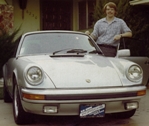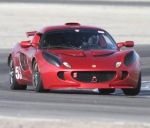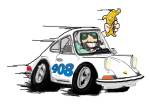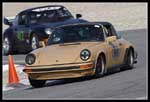I think there are other sanctioning organizations with similar "DNF correction" rules.
It works better with a single car on the course (like Pro-Solo), but with our events, there are obvious issues with safety and the practicality of timing.
Hitting / Missing Slalom cones
24 posts
• Page 2 of 2 • 1, 2
Re: Hitting / Missing Slalom cones
Paul D. Young http://www.deadpetsracing.com/
PCA Nat'l Club Race Advocate
Now: '78 911SC, '79 911SC, '04 955-S, '06 997-S, '88 924-S, '16 92A
Past: '74 914, '78 911SC, '78 928, '80 924-S, '82 931, '86 930, '03 996-4S
PCA Nat'l Club Race Advocate
Now: '78 911SC, '79 911SC, '04 955-S, '06 997-S, '88 924-S, '16 92A
Past: '74 914, '78 911SC, '78 928, '80 924-S, '82 931, '86 930, '03 996-4S
-

pdy - Time Trialer
- Posts: 466
- Joined: Thu Aug 05, 2004 2:32 pm
- Location: 2nd Place - Usually
Re: Hitting / Missing Slalom cones
Last month I came up to the slalom, the lead cone was already down, I went around it, and the corner worker called in a DNF. As it was my fastest run of the timed runs, I was pretty ticked. We need to make sure the corner workers know the rules on slalom cones!
-R
-R
Russell
PCA Zone 8 Rules Tech Advisor
Z8 TT/DE Chair ('20-'22)
Z8 Rules Chair ('12-'18)
Porsche Boxster S
Scion FR-S
Lotus Exige S
Toyota 4Runner TRD Off Road
PCA Zone 8 Rules Tech Advisor
Z8 TT/DE Chair ('20-'22)
Z8 Rules Chair ('12-'18)
Porsche Boxster S
Scion FR-S
Lotus Exige S
Toyota 4Runner TRD Off Road
-

rshon - Time Trialer
- Posts: 356
- Joined: Tue Feb 14, 2006 8:07 pm
- Location: Tace et Fruor Equito
Re: Hitting / Missing Slalom cones
rshon wrote:Last month I came up to the slalom, the lead cone was already down, I went around it, and the corner worker called in a DNF. As it was my fastest run of the timed runs, I was pretty ticked. We need to make sure the corner workers know the rules on slalom cones!
-R
Russell-
That is just wrong, in so many ways. Everyone deserves a shot at an undisturbed track in all their timed runs. If the corner workers do not have time to reset downed cones before the next car arrives, we are sending drivers out with too close an interval (or the workers are not paying adequate attention). You should have slowed down when you saw the cone down and pointed it out to a corner worker, then been allowed a rerun, unless you figured the downed cone did not impede your progress and you decided to proceed with the run, still driving on the prescribed course as if it had been standing. In that case, your time should have stood, and you got screwed instead by a bad call, which is the reason you might as well give up the run and point the cone out. There is too big a chance that the corner worker will either think that you did not drive completely around the point where it had been standing, or even assign you responsibility for knocking it over if they were distracted and did not see the original incident. I have encountered downed cones on the line many times at our events and ignored them, trying to save a good run, and have never (or maybe, very rarely) been wrongfully called for them or assigned a DNF, so I think your situation was fairly unusual, but it depends very much on the experience and focus of the cornerworkers. I can tell you that in SCCA events, everyone stops for downed cones--it is a real advantage to get a rerun, since you only get 3 runs total with no practice. Having an extra look at the course from your car is a big bonus.
We had plenty of extra time on Sunday, and it was a difficult course to run cleanly (and easy to overdrive and make mistakes). I know Bill said that we increased the interval, but it obviously was not enough, or we did not hold the start often enough to rebuild the track after incidents in order to give everyone an equal shot, based on the higher number of complaints this week. I would have to say that some of the blame possibly lies with the drivers, too, in taking a cavalier attitude about knocking cones over while trying too hard to be fast and making a lot of mistakes. I know the idea of an autox is to drive 110% in a safe environment and that the penalty for mistakes is mild, but I tend to still try to drive each autox course as if it was a road course with consequences--building up speed slowly and not tossing the car around every corner from the get-go. I think I hit one or two cones and had one near-spin all day, on my last run. Maybe I gave up a little time by not driving like my hair was on fire every lap, but at least I didn't make the cornerworkers sweat much.
TT
Tom Tweed -- #908
SDR Tech Inspection Chair 2005-06
SDR Forum Admin 2010-present
Windblown Witness Assistant Editor 2012-present
Driving Porsches since 1964
SDR Tech Inspection Chair 2005-06
SDR Forum Admin 2010-present
Windblown Witness Assistant Editor 2012-present
Driving Porsches since 1964
-

ttweed - Admin
- Posts: 1851
- Joined: Fri Jul 02, 2004 7:13 am
- Location: La Jolla, CA
Re: Hitting / Missing Slalom cones
Is it an unspoken taboo to hit cones during timed runs? I usually don't hit too many cones, but don't mind if others do during any part of the day. ( like the exercise actually.)
If it is taboo, well, too bad I guess. Just don't want to wipe out the Timing Lights.
(Regretfully, am a member of the TLC)
Oh yeah, Russell, I feel for you too, and don't blame you one bit for being p.o'd
If it is taboo, well, too bad I guess. Just don't want to wipe out the Timing Lights.
(Regretfully, am a member of the TLC)
Oh yeah, Russell, I feel for you too, and don't blame you one bit for being p.o'd
Jennifer Reinhardt
'07 Cayman S ~ #504 CC11
Past ~ Board of Directors, AX Registration, Social, '90 964 Carrera 2, and '99 986 Boxster
'07 Cayman S ~ #504 CC11
Past ~ Board of Directors, AX Registration, Social, '90 964 Carrera 2, and '99 986 Boxster
-

jenniferreinhardt - Time Trialer
- Posts: 437
- Joined: Mon Jul 03, 2006 3:52 pm
- Location: Zone 8
Re: Hitting / Missing Slalom cones
I'll get more serious below..... Russel - you don't look too upset in your avatar!  Do explain!
Do explain!
OK, more serious now.
1) We did leave more time sending cars out but it's apparent it was not enough time. I think we learned a lot this weekend about having a long challenging course and minimal corner stations due to the number of entrants. We definitely need to have more time btween send offs and should do this when this type situation occurs again.
2) I remember being told way back (can't remember where) that if a cone is down in the timed runs, come to a stop and point it out to the corner worker and they then call in to the trailer to tell timing you get a re-run. I brought this up at the driver meeting. The safety factor of stopping on the course was brought up - as ...no way! Upon thinking of some of the speeds we reach, stopping is a bad idea. Then I mentioned putting your hand out - hmmm, we aren't supposed to do that. Then I mentioned HONK your horn.
If a cone is down and you fear it might be called on you, I think the solution might be to slow down a bit and HONK the horn a few times. Hopefully the corner worker hears it - the corner worker (or another nearby corner who is not busy) should then call in to timing to get you a re-run. Then, if the corner worker can't get the cone up before the next car(s)arrives and/or the situation is getting out of hand - call in to START to hold the track and we'll then all figure out who gets re-runs.
Also, as was previously mentioned, if a corner worker doesn't actually see the cone get hit, they shouldn't call it in. We shouldn't make assumptions about who hit the cone if we didn't see it.
Yikes - I have some other thoughts but have to get back to work. Anybody else have a solution? Anybody not have a horn? (probably - but rare?)
OK, more serious now.
1) We did leave more time sending cars out but it's apparent it was not enough time. I think we learned a lot this weekend about having a long challenging course and minimal corner stations due to the number of entrants. We definitely need to have more time btween send offs and should do this when this type situation occurs again.
2) I remember being told way back (can't remember where) that if a cone is down in the timed runs, come to a stop and point it out to the corner worker and they then call in to the trailer to tell timing you get a re-run. I brought this up at the driver meeting. The safety factor of stopping on the course was brought up - as ...no way! Upon thinking of some of the speeds we reach, stopping is a bad idea. Then I mentioned putting your hand out - hmmm, we aren't supposed to do that. Then I mentioned HONK your horn.
If a cone is down and you fear it might be called on you, I think the solution might be to slow down a bit and HONK the horn a few times. Hopefully the corner worker hears it - the corner worker (or another nearby corner who is not busy) should then call in to timing to get you a re-run. Then, if the corner worker can't get the cone up before the next car(s)arrives and/or the situation is getting out of hand - call in to START to hold the track and we'll then all figure out who gets re-runs.
Also, as was previously mentioned, if a corner worker doesn't actually see the cone get hit, they shouldn't call it in. We shouldn't make assumptions about who hit the cone if we didn't see it.
Yikes - I have some other thoughts but have to get back to work. Anybody else have a solution? Anybody not have a horn? (probably - but rare?)
'80 911SC (AX FUN)
'94 968 "Practical" Porsche
'94 968 "Practical" Porsche
-

Bill Behun - Time Trialer
- Posts: 278
- Joined: Mon Feb 14, 2005 10:23 am
- Location: San Diego
Re: Hitting / Missing Slalom cones
Bill Behun wrote:Anybody else have a solution? Anybody not have a horn? (probably - but rare?)
Hmm...I have a feeling we will be seeing the race cars without horns employ the "air horn fastened to the roll cage" technique...that should get the corner worker's attention

Sounds like several factors contributed all at once to create an atypical situation for corner workers all day long. I know in my corner station 8 I was soaked with sweat due to the trouble spots being at opposite ends of my very large zone. I radio'd in and made sure my replacement didn't mind a good cardo workout! I stuck around after he came out for another run group or so to lend a hand as it was almost commical how many cones people were hitting (especially Jackie C...I'm not kidding either, it was laughable to the point of yelling at her as she drove by).
I personally don't feel stopping for a downed cone is the best solution...slowing and honking is a good idea if you have a horn (but then you know there will be the occasional accidental honk to confuse everyone) but then that leaves the non-horn equipped cars with an issue...not sure the best solution aside from the aforementioned air horn.
Since the success of the timed runs lies in the coner workers' ability to do their jobs effectively, more effective communication via radio between the starter and each corner could go a long way to ensuring smoother operation. One possible suggestion is in the future when there is a shortage of optimal corner workers for a given track that the starter be given the additional duty of rechecking with corner workers after a cone-slaughtering run. Specifically, if the starter hears over the loud speaker or radio that a cone(s) have been called in he/she should hold start and get on the radio for confirmation from that corner worker that the cone(s) have been reset before launching the next car. It will take more time but should ensure a higher level consistency and accuracy. Yes, the car or two following the car knocking down cones might might still get caught in limbo but they can slow and use their horn if they feel they might be called on a cone.
Oh and Bill, don't let these recent issues disuade you from making fast/long tracks like that...I really enjoyed it!
Adam Gill #115
Past Chief Driving Instructor
PCA National DE Instructor
'98 Boxster - "CUPCAKE" - CC3 before spinning rod, CC? coming soon
'97 993 Arena Red C"2"S - "Ruby"
'65 912 Gulf Blue - "Blue Bird" (sold)
Past Chief Driving Instructor
PCA National DE Instructor
'98 Boxster - "CUPCAKE" - CC3 before spinning rod, CC? coming soon
'97 993 Arena Red C"2"S - "Ruby"
'65 912 Gulf Blue - "Blue Bird" (sold)
-

AGill - Time Trialer
- Posts: 264
- Joined: Tue Jul 07, 2009 9:21 am
Re: Hitting / Missing Slalom cones
jenniferreinhardt wrote:Is it an unspoken taboo to hit cones during timed runs? I usually don't hit too many cones, but don't mind if others do during any part of the day. ( like the exercise actually.)
If it is taboo, well, too bad I guess. Just don't want to wipe out the Timing Lights.
It's not an "unspoken taboo" to hit cones during timed runs, or any other time, Jennifer, because sometimes people have to test the limits to find out where they are. But in timed runs, if your class is competitive, the 2-second penalty will put you out of contention, most likely, so it is a taboo in that sense. Hitting cones during a parade or practice lap probably carries more of a stigma, since you aren't supposed to be driving at 10-tenths then, and should be able to control your car. Wiping out the timing lights is definitely bad form, especially if it causes a big delay, or you break them and there are no spares to replace them. Mowing down an entire row of cones trying to save a slide or an out-of-control situation can be frowned on somewhat when it delays the event while the workers rebuild the course, but one or two cones here or there are commonplace and expected. The issue is getting them replaced before the next car comes by. Having to avoid a displaced cone on the course by driving off line, or having an apex cone missing that allows you to cut a corner does not make for fair competition.
It all comes down to the interval between cars and the number of cornerworkers, both of which were in short supply on Sunday, while we were LONG on numbers of downed cones. In an SCCA national event, they can tell every driver which cone they hit on every run, unequivocably. They will set up a shorter course, with fewer cones deployed (a more "open element" design than the "corridor of cones" we seem to prefer), with more corner stations, less spread out, and 3 (yes, three) people working each corner. One person resets the cone, one person calls it in on the radio, and the 3rd person records it in a log. Every cone on the course is numbered on the course map, and the log of downed cones is returned to timing and scoring after each heat to be shown to the drivers. Of course, they can do this because there may be 300 people competing in a day, and only getting 3 runs each. Obviously, we have different attendance levels and different goals at our events, and our results are different. Frankly, I enjoy our events more, but we can't expect that kind of precision with our methods.
TT
Tom Tweed -- #908
SDR Tech Inspection Chair 2005-06
SDR Forum Admin 2010-present
Windblown Witness Assistant Editor 2012-present
Driving Porsches since 1964
SDR Tech Inspection Chair 2005-06
SDR Forum Admin 2010-present
Windblown Witness Assistant Editor 2012-present
Driving Porsches since 1964
-

ttweed - Admin
- Posts: 1851
- Joined: Fri Jul 02, 2004 7:13 am
- Location: La Jolla, CA
Re: Hitting / Missing Slalom cones
The main problem was a shortage of corner workers. They worked there butts off 
Any corner worker can request HOLD START at any time, for any reason.
Reruns were not a problem untill the last two run groups.
EVERYBODY KNOWS IT'S ALL JACKIE'S FAULT.

Any corner worker can request HOLD START at any time, for any reason.
Reruns were not a problem untill the last two run groups.
EVERYBODY KNOWS IT'S ALL JACKIE'S FAULT.

JERRY BUMPUS
Semi Retired Autocross Chair
2004 Cayenne Turbo The Great White Beast
2006 Cayman S The Other White Car
91 944s2 aka The White Car
89 944 TAZ The Not White Car
87 944s Ka BOOOM Car sold
86 944 aka The Black Car sold
Semi Retired Autocross Chair
2004 Cayenne Turbo The Great White Beast
2006 Cayman S The Other White Car
91 944s2 aka The White Car
89 944 TAZ The Not White Car
87 944s Ka BOOOM Car sold
86 944 aka The Black Car sold
-

JERRY B - Time Trialer
- Posts: 471
- Joined: Thu May 14, 2009 1:52 pm
- Location: THE DIDO
Re: Hitting / Missing Slalom cones
oh Jerry, are you sure you don't want to retract that statement? Can you say retribution? I forgot, you'll be an autocross chair next year. We're even. 
Jackie Corwin
-

Jackie C - Time Trialer
- Posts: 454
- Joined: Tue Jul 06, 2004 11:46 am
- Location: Vista, CA
24 posts
• Page 2 of 2 • 1, 2
Who is online
Users browsing this forum: No registered users and 26 guests
